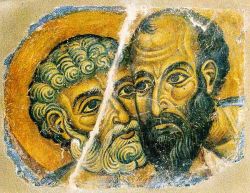An embrace in martyrdom and the primacy of charity
by ENZO BIANCHI
Peter and Paul, both of them disciples and apostles of Christ, are nevertheless so very different: Peter a poor fisherman, Paul a rigorous intellectual
29 June
The solemnity of the holy apostles Peter and Paul unites in a single celebration Peter, the first disciple called in the synoptic accounts, the first of the twelve apostles, and Paul, who was not a disciple of Jesus and did not belong to the group of the Twelve, but whom the Church calls “Apostle”, preeminently the one sent, although this title, which he presumes to apply to himself, is never attributed to him in the Acts of the Apostles. This feast is already attested in the oldest liturgical calendar that has come down to us, the Depositio martyrum of the third century, which places together two of Jesus’ apostles who died in Rome at different times, but both of them martyrs, victims of the persecutions of Christians: two lives offered in libation for the cause of Jesus and of the Gospel.
The two apostles are thus united in the liturgical celebration, after their earthly lives saw them even opposing one another: a communion lived in evangelical parresia and for that very reason not always easy, in fact, often difficult. The limestone bas relief preserved in Aquilea, like the traditional iconography that depicts their embrace, intends to express this very communion at high cost that guaranteed the labors of each of the two as the foundation of the Church of Rome, the place where their race had its end, the place that saw both of them martyrs in Nero’s time, put to death for the same reason.
